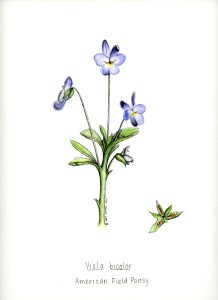| Common Name(s) | American Field Pansy, Wild Pansy | ||||
| Scientific Name | Viola bicolor | ||||
| Family | Violaceae | ||||
| Location/Vegetative Zone | Fields | ||||
| Flowering Period | Mid spring- early summer for 1½ months | ||||
| Identifying Characteristics | 4-6” tall, slender basal-shaped leaves, and purple/white flowers with dark purple lines | ||||
Description
- Annual plant
- Grows 6” tall
- Leaves:
- Small, basal-shaped
- 2” long
- Light to medium green
- Hairless and smooth
- Has purple/ white flowers
- 5 petals
- Medium blue-violet becoming white toward the center
- Dark purple lines radiating outward
- Blooms from March-June for about 1½ months
- Fertilized flowers produce seed pods with small, light brown seeds which are ejected out of the pod
- Habitat:
- Limestone glades, moist sand prairies, fields, edges of sandy paths, and waste places
- Likes light friable soil containing sand, but will adapt to other kinds of soil as well
- Is considered native to North America (although this is controversial) and can be found from Western Canada to the East Coast of the US down to Texas
- Likes full or partial sun, moist to mesic conditions and areas with a history of disturbance
Medicinal/Edible Uses
- Cooked down with sugar to make jellies and syrups
- Used to garnish plates
- Flavors some oils, vinegars, butters, and beverages
Cultural Uses
- Ornamental
- Romans used plant to make wine
- In medieval times, people would scatter American Field Pansy on the floor to freshen the air
- In the Victorian era the flower was used to make fragrances and perfumes
Misc
- Attracts bees, small butterflies and moths; many types of birds including the grouse and wild turkey feed on the seeds; deer and rabbits will feed on the foliage
- In the past, there has been some controversy regarding whether or not the Field Pansy is native to North America as it shares many characteristics with the Viola spp., a plant from Eurasia. However, the growing consensus is that the Field Pansy is a distinct species and therefore is considered native to North America
Sources
Boling, Janice. “Using Viola in Herbal Medicine and Home Remedies”. Every Green Herb. Web.
“Viola bicolor Pursh field pansy”. Plants Database. USDA NRCS. Web.
“Viola Flowers”. Specialty Produce. Web.
3,921 total views, 1 views today

